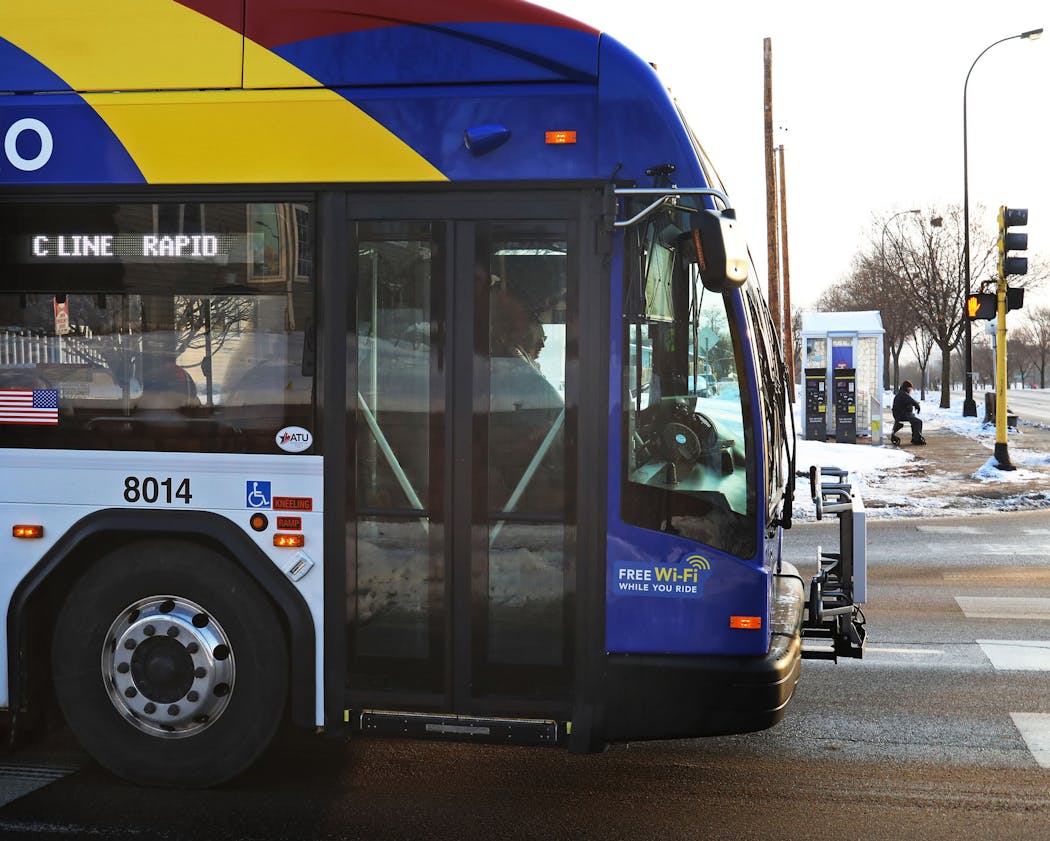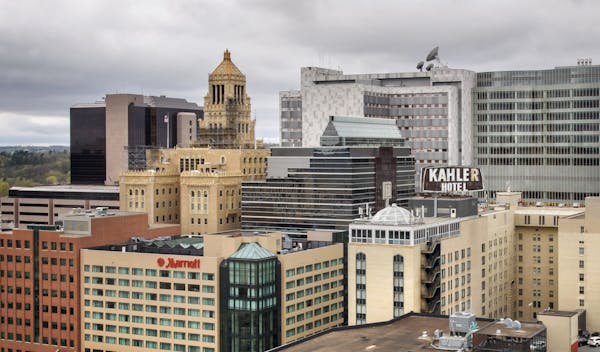Six years after Ramsey County leaders endorsed a streetcar for W. 7th Street in St. Paul, a new idea for public transit along the busy corridor has emerged: a bus line that is more than a billion dollars cheaper to build.
County transit planners last month released details for arterial bus-rapid transit (aBRT) service that would cost at least $121 million and connect downtown St. Paul with Minneapolis-St. Paul International Airport and the Mall of America.
The so-called Riverview Corridor would join a growing stable of aBRT routes throughout the metro, a popular service that features heated and well-lit stations, payment-before-boarding, and 10-minute service during peak hours.
But some are still championing a streetcar, despite a $2.1 billion price tag and a complicated route to the Bloomington megamall that calls for a new bridge over the Mississippi River and a new station at Fort Snelling, sacred space for Indigenous tribes.
This summer, Ramsey County will gauge public opinion on the matter through a series of open houses and other outreach efforts. Come fall, a key advisory committee will make a recommendation.
"The public will really need to chew on these options," said Russ Stark, St. Paul's chief resilience officer, who serves on the project's Policy Advisory Committee. "We expect a wide variety of opinions."
Enter arterial BRT
In 2018, the Ramsey County Board voted unanimously to support streetcar service along the Riverview Corridor. More compact than light rail, this type of streetcar would run mostly in a dedicated lane. If built, it would signal a return of streetcar service to the Twin Cities for the first time since 1954.
In recent weeks, transit planners have offered more details about aBRT service using electric buses in the Riverview corridor, an option they say was always under consideration.
With three aBRT lines currently running, several under construction, and more planned, Metro Transit has bet big on this mode of transport. The A Line debuted in 2016, connecting Rosedale mall with the Blue Line's 46th Street station in Minneapolis, largely along Snelling Avenue in St. Paul.
Arterial bus-rapid transit runs in traffic, so it's susceptible to back-ups, although buses have signal priority at intersections. While an improvement over workaday local bus service, transit planners say it doesn't have the same sway with real estate developers as light rail, or perhaps a streetcar, who may be intent on building apartments or retail.
Replacing the corridor's Route 54 bus with a streetcar will be challenging, according to county presentations released in recent weeks.
The Riverview route begins in downtown St. Paul and features many local streets zig-zagging with W. 7th, and a narrow stretch of bars and restaurants near Xcel Energy Center that is often crowded with revelers on event days.
Then there's the effect of construction on businesses, as well as the challenges associated with the Hwy. 5 bridge; a pathway through Fort Snelling, a national landmark; plus shared track with the Blue Line light rail leading to MSP airport and a new elevated station at the Mall of America. And, being St. Paul, there's a contingent worried about the loss of trees, no matter what's built.
"We are trying to get good transit to fit in with the existing community and make places as attractive as we can for people to live, work and spend time," Stark said.
Leaders will also have to justify a $2 billion streetcar project in light of the nearly $3 billion Southwest light-rail project with its cost overruns and delays, not to mention the struggle with crime aboard Metro Transit trains and buses.
"No doubt they all have negative impact," said Rafael Ortega, the Ramsey County commissioner who is championing the streetcar project. "We are constantly anticipating and updating [plans.] We feel good about our project financially," he said of lessons learned from Southwest. "We're making sure we get the best value for our dollar."
"All of these things will work themselves out," Ortega said.
Streetcar slower than bus
The county has suggested two streetcar options: The main difference is one features additional stations at Smith and Jefferson avenues in St. Paul. The first option uses a dedicated lane for about 10 miles, the second, for 8 miles.
End-to-end streetcar travel times vary from 43 to 45 minutes – about five minutes slower than aBRT and three minutes slower than the Route 54. The bus routes are slightly different. For example, the streetcar would drop passengers off at both MSP airport terminals, but the aBRT bus proposal would only serve Terminal 1.
Average weekday ridership for the streetcar is expected to reach between 11,200 and 11,600 by 2040, and 8,000 on aBRT. But transit planners say the estimates will be retooled after the Metropolitan Council updates its post-pandemic ridership models. (The council has not been involved in planning Riverview.)
"Travel patterns have changed [post pandemic], but [the route] actually lends itself really well to a streetcar which is very frequent, all-day short trips," said Jennifer Jordan, Ramsey County's senior transportation planner for the project. "So we expect when we rerun the ridership model we'll see that start to stand out."
Both the streetcar and aBRT option would provide service every 10 minutes from early morning into the evening, and every half hour beyond that.
The Hwy. 5 bridge spanning the Mississippi River would have to be replaced to accommodate the streetcar, a project Ortega said could cost around $500 million, while aBRT would use the existing bridge, which underwent a $14 million reconstruction in 2016.
W. 7th Street would be resurfaced to accommodate the streetcar, work that is baked into the overall cost. The bus option would require a $200 million street overhaul, not included in the current price tag.
The Federal Transit Administration (FTA) is expected to pay about half of the cost of the streetcar project, with Ramsey and Hennepin counties paying the rest. The bus would be funded mostly with state and local money. To date, the county has spent $11.7 million on the Riverview Corridor project.
Ortega said choosing a streetcar will have the side benefit of a new Hwy. 5 bridge and a redo of W. 7th. "This is an opportunity to get the federal government to pay half the cost, otherwise it will be borne by local government," he said.
And then there's parking
Parking before and after streetcar construction is a hot issue for Riverview, especially along W. 7th. The first streetcar proposal leaves just 35 parking spots along the stretch, while the second would preserve 400 spaces. For aBRT, 570 parking spots would remain, a loss of about 70 spaces.
To W. 7th resident Joe Landsberger, who serves on several Riverview committees, eliminating parking for a streetcar is lunacy.
"You lose customers and diminish traffic; they're out to destroy a very vital business district," he said. "There aren't many empty storefronts along W. 7th like Grand Avenue, where East Coast pension funds own the buildings. These are locally owned businesses."
Remade Stillwater riverfront could bring new parks, boat launch, picnic space and fishing piers
Minnesotan's path from ISIS front lines to asset in war on extremism will be on display at sentencing

In Grand Rapids, Itasca Pride is planning its first event, but there is already pushback
One person shot at YMCA in Coon Rapids



